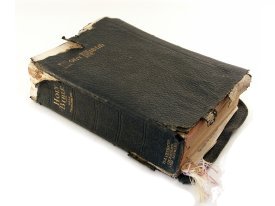When we think about reading the Bible, do we ever imagine that there might be a danger of reading it wrongly? Consider the words of Eugene Peterson in his book Eat This Book…
Reading the Bible, if we do not do it rightly, can get us into a lot of trouble. The Christian community is as concerned with how we read the Bible as that we read it. It is not sufficient to place a Bible in a person’s hands with the command, “Read it.” That is quite as foolish as putting a set of car keys in an adolescent’s hands, giving him a Honda, and saying, “Drive it.” And just as dangerous. The danger is that in having our hands on a piece of technology, we will use it ignorantly, endangering our lives and the lives of those around us; or that intoxicated with the power that technology gives us, we will use it ruthlessly and violently.
For Peterson, a way to read Scripture that “guards against depersonalizing the text into an affair of questions and answers, definitions and dogmas; a way of reading that prevents us from turning Scripture on its head and using it to justify ourselves,” is the lectio divina.
The lectio divina comprises four elements:
- Lectio – we read the text. This reading of the text involves listening to the text. “Just because we have read it,” writes Peterson, “doesn’t mean we have heard it.” And we must be careful not to “assume too much” of the text but to “listen to the counsel of our Christian brothers and sisters who tell us, ‘Read. Read only what is here, but also be sure that you read it the way that it is here.'” This involves developing good hermeneutics. This reading does not bypass the grammatical-historical method of interpretation.
- Meditatio – we meditate the text. “Mediation,” writes Peterson, “moves from looking at the words of the text to entering the world of the text.” It is not about making things up, but instead weds us “to a historic faith…that trains us to read Scripture as a connected, coherent whole, not a collection of inspired bits and pieces.”
- Oratio – we pray the text. Peterson declares that “Scriptures, read and prayed, are our primary and normative access to God as he reveals himself to us. Prayer detached from Scripture, from listening to God, disconnected from God’s words to us, short-circuits the relational language that is prayer.”
- Contemplatio – we live the text. “Contemplation,” says Peterson, “means living what we read, not wasting any of it or hoarding any of it, but using it up in living. It is life formed by God’s revealing word, God’s word read and heard, meditated and prayed.”
For Peterson, the lectio divina is the method of reading which guards against us turning the Scriptures into an academic book or a book such as Aesop’s Fables. He wants us to enter the text and allow the grand story of Scripture to rewrite our own personal stories. This, for Peterson, is reading the Bible rightly!

Be First to Comment